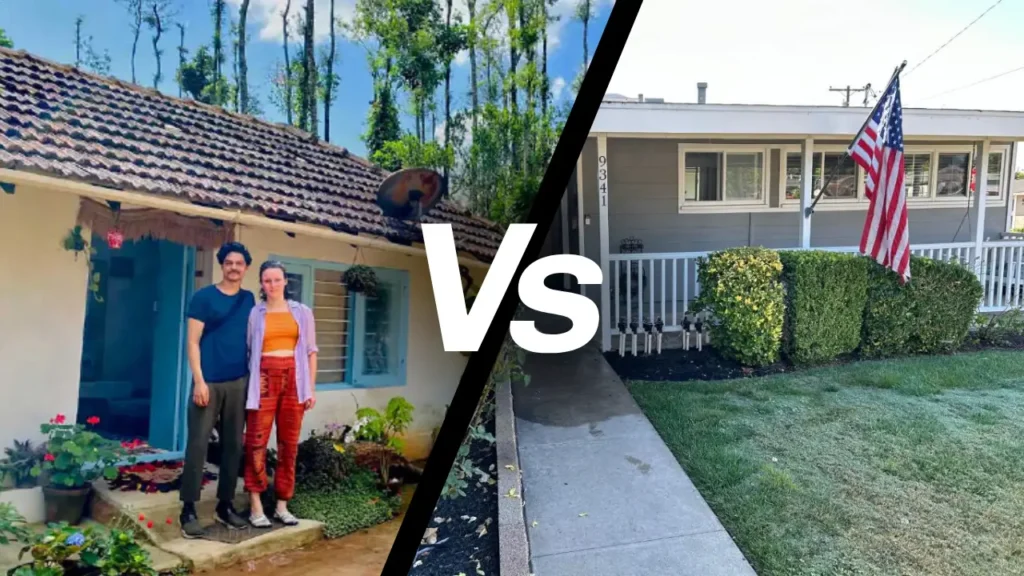Homestay travel has surged globally, but Indian homestays offer a uniquely enriching experience compared to Western or other international destinations. From cultural depth to culinary diversity and provider mindset, Indian homestays stand apart in eleven remarkable ways. Here’s a detailed exploration of what sets them apart—with data, anecdotes, and practical tips.
Table of Contents
1. Cultural Integration vs. Convenience Stay
Unlike many Western homestays, often set up like homelike Airbnbs, Indian homestays prioritize cultural exchange.
- Home-based integration: Indian hosts invite guests into their daily lives—sharing meals, chores, crafts, and family events.
- Local festivities: From tribal dance nights to village weddings, guests are immersed in living traditions—a rarity abroad.
“I learned how to make millet rotla in Gujarat and joined a village festival. That kind of experience is impossible to find elsewhere.” — Guest review, VanGhar
In contrast, international homestays, especially in the U.S. or Europe, often aim to replicate mid-range hotel experiences, with limited interaction.
2. Organic, Farm-Fresh Meals vs. Standard Menus
Food plays a starring role in Indian homestays and farm stays.
- Farm-to-plate: Many Indian homestays grow their own produce—ranging from baigan to local millets.
- Seasonal variety: Meals rotate with harvests—guests eat mango curries in summer and pumpkin sabzi in winter.
- Traditional cooking methods: Wood-fired chulhas, clay ovens, or solar cookers bring authenticity.
By contrast, foreign homestays often rely on deliveries or standardized store-bought goods, lacking local flavor. A 2022 Booking.com survey confirmed that 82% of travelers seek local cuisine when staying abroad, favoring Indian rural stays.
3. Low-Tech Simplicity vs. High-Tech Comfort
Indian rural homestays often operate with minimal technology: basic fans, filtered water, simple solar lights. Yet they offer:
- Authentic ambiance: Forest sounds, clay walls, and starlit skies.
- Resourcefulness: Solar lamps and rainwater harvesting reduce costs and utility use.
By contrast, foreign homestays may provide Wi-Fi, AC, and Smart TVs, offering convenience but missing the rustic charm that many Indian travelers crave.
4. Affordability Without Compromise
Indian homestays deliver strong value: average nightly rates are ₹2,000–₹3,500, while offering meals and activities included.
- In Ladakh, rates may even reach ₹6,000–₹8,000 but come bundled with meals, guided treks, and local transport.
- According to Cognizant Research (2024), Indian homestays cluster around this high-value bracket—ideal for the growing domestic travel market.
Foreign homestays, especially in Europe or North America, can cost upwards of $100 per night, often with fewer experiences.
5. Multilingual, Personalized Hosting vs. Formal Management
Indian homestay hosts typically speak Gujarati, Hindi, Tamil, or other regional languages, often with some English.
- Hosts manage everything—from cleaning to culinary planning to guest engagement.
- This direct, personalized relationship fosters trust and a sense of family.
Foreign homestays often employ part-time managers or use remote platforms, making the experience more transactional and less personal.
6. Hybrid Home-and-Community Stays vs. Private Stays
In India, homestays often form community clusters or village eco-camps, where guests stay with multiple families.
- Ideal for those exploring local crafts, farm visits, or tribal cooking demos.
- This model reduces individual risk while offering more integrated experiences.
In contrast, foreign homestays often involve a single host renting out rooms in their own home, with limited communal learning or group engagement.
7. Living Heritage vs. Vintage Replication
Many Indian homestays are ancestral homes—mud-walled, wood-beamed, centuries old.
- A homestay near Jaipur might be a 200-year-old haveli with frescoes.
- A Khasi cottage in Shillong could reflect centuries of tribal architecture.
Instead of replicating history for tourists, these homes are lived-in heritage. Foreign “heritage homestays” often rebuild or stylize historic elements, but few are actual descendants’ homes.
8. Experiential Extras vs. Standard Amenities
Beyond rooms and meals, Indian hosts include:
- River rafting, tribal meals, medicinal herb walks, or natural dye workshops.
- Asia-Pacific region: 67% of travelers say authentic local experiences are essential to their travel decision (UNWTO data, 2023).
Western homestays may offer city tours or museum tickets but often lack organic integration with lifestyle.
9. Regulated by Local Schemes vs. Minimal Tourism Oversight
Indian homestays benefit from government yojanas (schemes) like Uttarakhand Homestay, MP Responsible Tourism, or Goa’s Sustainable Tourism policies.
These schemes offer:
- Subsidies, interest relief, tax breaks
- Training, hygiene certification, signage
- Support for women and young entrepreneurs
In many foreign countries, homestays fall outside formal tourism oversight, lacking local training or association benefits.
10. Peer-to-Peer Trust vs. Platform Reliance
Indian hosts leverage not just global platforms like Airbnb but also WhatsApp groups, local tourism sites, and aggregators like VanGhar.in.
- Rural hosts staff community centers or village tourism desks for direct booking.
- They share WhatsApp “broadcast” listings and create guest groups for referrals.
This mobility contrasts with foreign markets that lean heavily on tech platforms for visibility and operations.
11. Social & Economic Impact vs. Profit-Driven Models
An Indian homestay’s success directly benefits:
- Host families, cooks, guides, artisans, and small transport providers.
- Village artisans: A biannual textile fair in Kutch increased craft incomes by 24% after homestay demand grew (Economic Times, 2023).
- Ecotourism villages in MP saw a 526% increase in tourism since launching homestays in 2020, generating community income and halting rural exodus.
Foreign homestays may spur local economies, but rarely achieve the same level of community turnaround and generational impact.
Summary Table: Indian vs. Foreign Homestays
| Feature | Indian Homestays | Foreign Homestays |
|---|---|---|
| Cultural Experience | Deep, living culture immersion | Moderate, scheduled interactions |
| Culinary Offering | Seasonal, homemade, farm-to-table meals | Standardized or urban menus |
| Tech Infrastructure | Low-tech authenticity | Tech-dependent comfort amenities |
| Cost Efficiency | Affordable stays with rich inclusions | Higher cost, fewer extras |
| Host Engagement | Multilingual, family-run interactions | Manager-based, sometimes remote |
| Accommodation Model | Village clusters/community stays | Solo/private homestays |
| Heritage Integrity | Genuine lived-in historic homes | Replicated or stylized vintage homes |
| Experiential Options | Local crafts, walks, workshops included | Tourism-itinerary-based activities |
| Regulatory Support | Yojanas, certifications, host training | Varies country by country |
| Booking Channels | WhatsApp, local sites, villages’ networks | OTAs and global platforms primarily |
| Economic Impact | Boosts whole communities | Limited co‑benefits to locals |
Why This Matters
Travelers are now seeking authentic experiences over polished luxury. Indian homestays offer exactly that—but are often overlooked due to lack of marketing.
- The homestay market in India was valued at US$540 million in 2024, with an 11% annual growth rate (Cognitive Market Research).
- Homestays make up just 5% of hotel-style accommodations, yet contribute 13% in emerging destinations, proving the untapped potential of rich, local experiences.
Understanding these 11 differences not only informs traveler choice—it empowers hosts to highlight unique selling points, deliver value, and differentiate their listings.

Final Thoughts
Indian homestays offer authentic immersion, social benefits, and living culture in ways foreign accommodations rarely can. While global homestays prioritize comfort and convenience, India’s model is richer, more meaningful, and transformative—for both guests and rural communities.
If you’re a traveler, consider choosing a homestay that offers family dinners, crafts with grandma, or an orchard supper. If you’re a host, lean into your strengths—culture, climate, and community—and invite the world to your heritage.
Let your homestay be more than just a place to sleep—let it be a story, a lesson, a shared memory. That’s the Indian difference.




